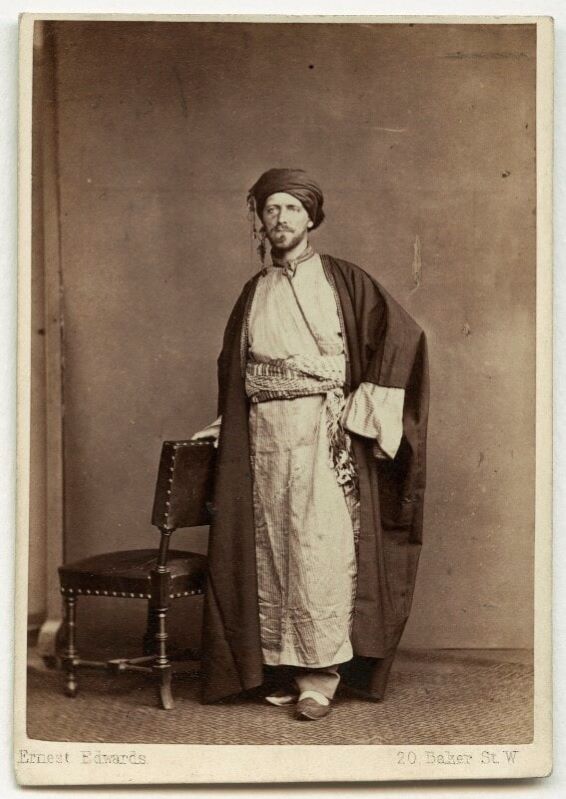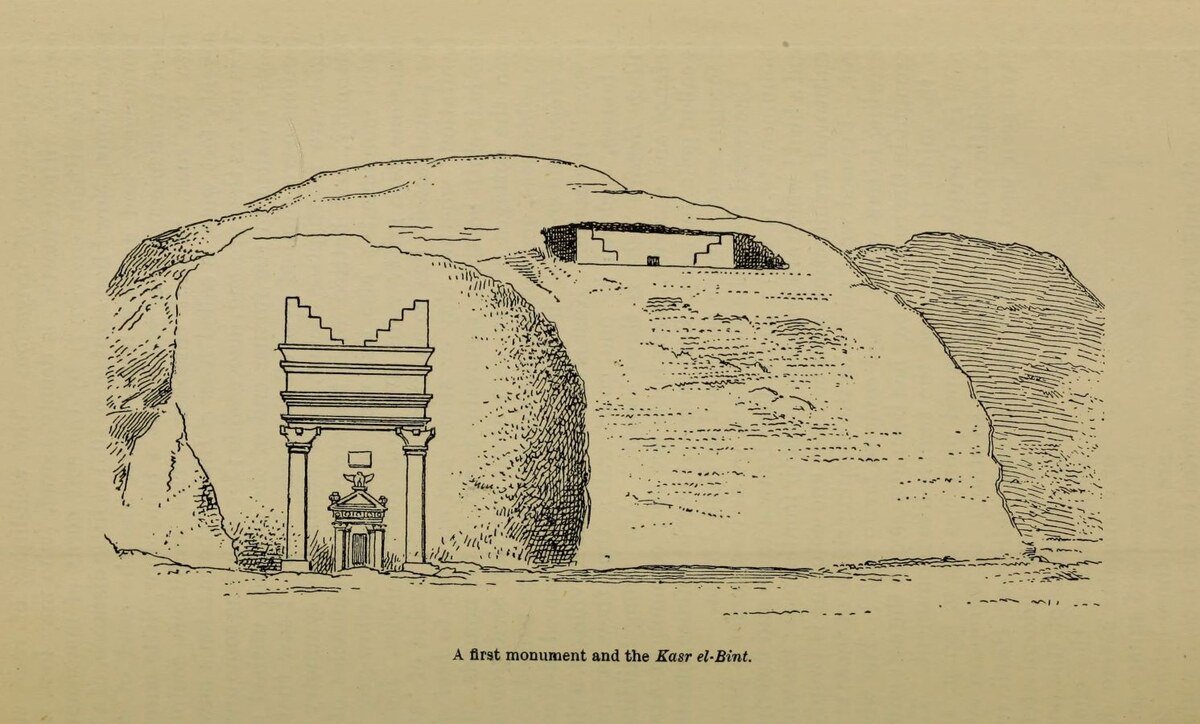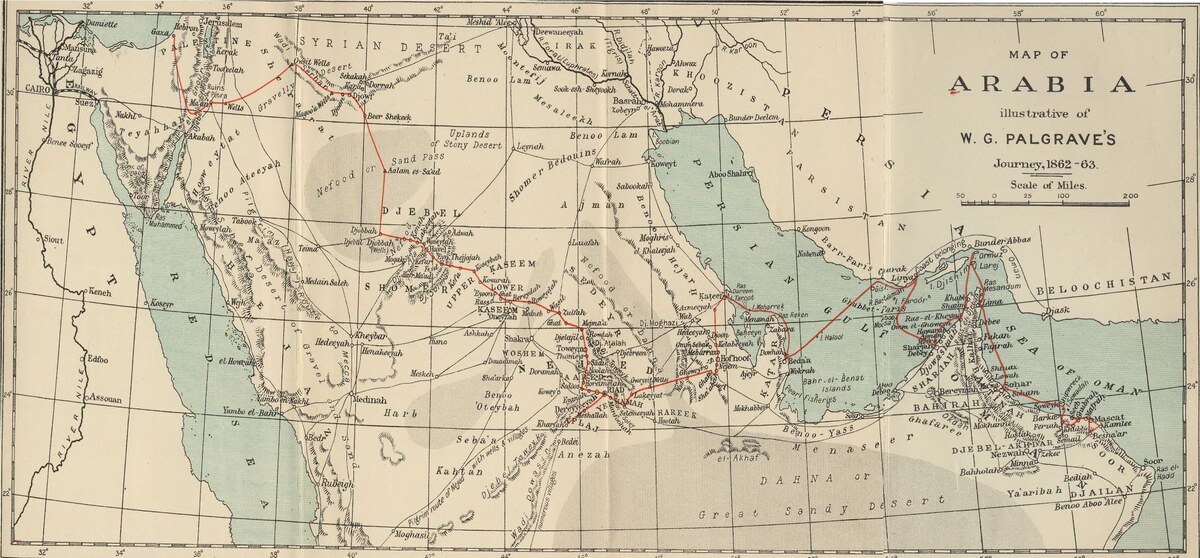DUBAI: Driven by romanticism, imperial ambition, and scholarly curiosity, a succession of European adventurers set sail for Arabia throughout the 19th century, laden with expectation and a desire to unravel its mysteries. For many, the goal was a deeper understanding of the region’s history, religion, geography, peoples, and wildlife, as well as the uncovering of Biblical truth. For some, natural history, ethnology, cartography, and archaeology were combined into a single expedition, resulting in the publication of multi-disciplinary personal narratives that fed the Victorian hunger for adventure, discovery, and escapism.

William Gifford Palgrave was an intriguing figure who served variously as a soldier, interpreter, priest, missionary, spy, and diplomat. (Supplied)
Among them were Charles Montagu Doughty — the first European to enter Hegra, the Nabateans’ second city after Petra — and James Raymond Wellsted, a second lieutenant of the East India Company, who survived a hurricane off the coast of Magna and took part in a detailed study of the Gulf of Aqaba. Arguably the most famous, however, was the eccentric Englishman Richard Francis Burton, a complex figure remembered for his keen sense of adventure, overt Orientalism, and undertaking the Hajj in disguise. He also embarked on an outlandish mission in search of the legendary gold mines of Midian, an ancient region or tribal confederation mentioned in both the Qur’an and the Bible and thought to be located in north-west Arabia.
The newly-published Arabian Explorers Series reintroduces travelogues by all three, as well as by William Gifford Palgrave, an intriguing figure who served variously as a soldier, interpreter, priest, missionary, spy, and diplomat. Published by Empty Quarter Press, the series seeks to bring the authors’ vivid depictions of Arabia to a new audience.
“Throughout their journeys, each author recorded some of the most detailed analyses and observations of Arabia in the English language and precious details about society, cultural customs, political structures, ancient heritage sites, and the shifting power dynamics of the peninsula in this period,” says Jeff Eamon, editor-in-chief at Empty Quarter Press. “We aim to couch each text in its proper context so readers can appreciate their significant historical value (and) understand each author’s subjectivities and perspectives.”

Charles Montagu Doughty was the first European to enter Hegra, the Nabateans’ second city after Petra. (Supplied)
The reprints include newly commissioned maps, glossaries, and forewords by leading historians, placing these complex and often provocative legacies in context. Included are new editions of Palgrave’s “Personal Narrative of a Year’s Journey Through Central and Eastern Arabia (1862-63),” first published in 1865; volume one of Burton’s “The Land of Midian (Revisited),” originally published in 1879; Wellsted’s “Travels in Arabia Volume Two,” printed in 1838; and Doughty’s “Travels in Arabia Deserta Volume One,” a monumental text first published in 1888.
“Much of the written information that we have about 19th-century Arabia comes from these travelogues,” explains Eamon. “They have long provided precious information for scholars, students of history, and general readers interested in Arabian culture, social customs, and heritage. With Saudi Arabia’s current investment in its wealth of cultural assets and heritage sites, these publications are amazing sources of information. Doughty, for instance, is the first to document Hegra in minute detail, with detailed sketches of the Nabataean tombs, which have become a major part of Saudi Arabia’s cultural offering.”

The four travelogues have inspired academic inquiry for over a century, but have also sparked debate, not least because of the biases inherent in their authors’ views. (Supplied)
The four travelogues have inspired academic inquiry for over a century, but have also sparked debate, not least because of the biases inherent in their authors’ views. Burton in particular, has faced accusations of Orientalism and of perpetuating stereotypical views of Arabia. His observations were often tinged with a sense of superiority and colonial arrogance, although he had great admiration for both Islam and Arab culture.
“Burton’s views on the Arab world were complicated,” admits Dane Kennedy, a historian of the British imperial world and author of the foreword to “The Land of Midian (Revisited).” “His comments on the Bedouin could be highly critical, though he also promoted a romanticized view of them as princes of the desert. Furthermore, he was a forceful defender of the Islamic faith and Arab culture, so much so that many of his countrymen ostracized him, believing him to be a convert to Islam.
“He was a man of many talents and vast contradictions. He was both an agent of British imperialism and a critic of it. He was a bigot and a relativist. He was, above all, a man of immense curiosity about other cultures, and he sought to satisfy that curiosity by learning some 25 languages, travelling widely across India, Arabia, Africa, Latin America, and other lands, and often acquiring an intimate knowledge of the local communities he encountered.”

William Gifford Palgrave was the first Westerner to successfully cross the Arabian Peninsula from the Red Sea to the Arabian Gulf. (Supplied)
Palgrave, who made a foolhardy attempt to cross the Nafud desert in July without local guides and barely made it to salvation in Jubbah, also viewed the world through a Eurocentric, colonial lens. The first Westerner to successfully cross the Arabian Peninsula from the Red Sea to the Arabian Gulf (west to east), he travelled in disguise — as a Syrian physician — and filled his narrative with vivid, compelling observations of the landscapes, tribal dynamics, and cultural practices of the Arabian Peninsula. He achieved immediate acclaim upon the publication of “Personal Narrative,” thanks in part to his love of storytelling.
“We are now more than 150 years on from Palgrave’s Arabian travels and his narrative can be read on various levels — from travelogue to adventure story,” says James Parry, a cultural heritage writer and author of the foreword to the new edition of “Personal Narrative.” “It’s worth remembering that he had a great sense of theatre and wrote his account with his audience very much in mind — it’s a very entertaining read. His descriptions of the places and tribes he visited are fascinating, even if some of his comments about local people and customs are seen as problematic today. They need to be understood as the product of their time, and his account as an historical document.”
All four travelogues filled in much of the outside world’s knowledge of the Arabian Peninsula. Burton’s account of his journey from Cairo to Makkah, for example, gave the British public a much richer understanding of the region and its peoples.
“Despite their flaws, it is important to recognize that each author spent years travelling in Arabia, learning the language and customs of its people long before mass transit made the peninsula easily accessible to outsiders,” says Eamon. “While some of their observations can be dismissed now, they nonetheless help paint a picture of pre-industrial Arabia.
“History-telling is fickle,” he adds. “It carries with it the same baggage that weighs down any human experience. The Arabian Explorers Series is just this: a collection of human experiences, however flawed, that contribute to the broader mosaic that is the history of Arabia.”























